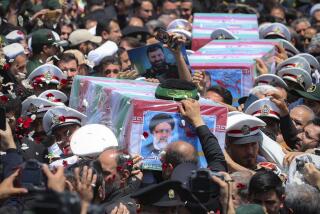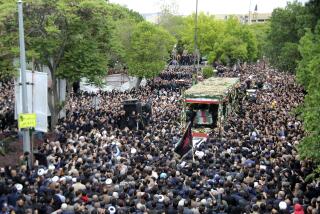A mix of protest and mourning in streets of Iran after death of top dissident cleric
- Share via
Reporting from Tehran and Dubai, United Arab Emirates -- Tens of thousands of opposition supporters took to the streets today in Qom, Iran’s main theological center, to mourn the passing of the country’s top dissident cleric, Ayatollah Hossein Ali Montazeri, who died late Saturday at the age of 87.
Witnesses described a steady procession of mourners walking from Montazeri’s home to the shrine of Fatemeh Masoumeh, where Montazeri was laid to rest. Despite the presence of security forces, many mourners chanted anti-government slogans and carried green ribbons and banners signifying allegiance to the opposition movement that sprang out of Iran’s disputed June presidential elections.
As the ceremony concluded, Montazeri’s son, Ahmad, asked mourners to disperse peacefully out of respect for the family. But there were a few reports of clashes between mourners and the security forces that had flooded the city, 90 miles south of the capital.
According to reformist news websites, pro-government militiamen pulled down a funerary banner honoring Montazeri.
Several hundred government supporters chanting slogans in support of Supreme Leader Ali Khamenei gathered near Montazeri’s home, according to news websites. Uniformed law enforcement had to intervene to prevent clashes from breaking out between government supporters and mourners, some of them throwing stones.
Official Iranian media has given limited coverage to Montazeri’s death and potentially volatile funeral and mourning ceremonies. They coincide with a key period on the Shiite calendar, when there were already expectations of confrontations between opposition protesters and the government.
“It was a very timely demise,” said an aide to opposition figurehead Mehdi Karroubi, who attended the ceremony along with fellow presidential candidate Mir Hussein Mousavi. He asked that his name not be published. “The grand ayatollah passed away at the zenith of his reputation among middle class and educated people of Iran.”
Montazeri supporters and opposition activists began pouring into the shrine city Sunday, many arriving from the senior cleric’s hometown of Najafabad.
From 8 a.m. on, cries of, “Death to the dictator,” and “Ya Hossein! Mir Hossein!” in support of opposition figurehead and former presidential candidate Mir Hossein Mousavi, could be heard from around his home, according to witnesses and amateur video footage posted on the Internet.
Wrapped in black cloth and mounted atop a truck also draped in black, his body emerged at around 9 a.m. to be taken slowly to the shrine and buried next to his late son, Mohammad, who was killed in a bomb blast during the early years after Iran’s 1979 Islamic revolution, witnesses said.
The boos of chanting mourners overwhelmed official slogans emanating from loudspeakers near the shrine that condemned the United States and supported Khamenei, who offered his condolences Sunday to Montazeri’s family, witnesses said.
“The green nation of Iran is in mourning,” chanted mourners, many dressed in green and holding green ribbons. “The oppressed Montazeri is before God.”
Perhaps the most striking image was the young female mourners who, instead of being swathed in black chadors, wore colorful and trendy waistcoats and attempted to enter the shrine grounds in violation of religious traditions.
Montazeri, an architect of Iran’s 1979 revolution and the man first designated as successor to its founder, Ayatollah Ruhollah Khomeini, fell out of the Islamic Republic’s inner circle following his criticism of the mass killing of prisoners in the late 1980s. He eventually became Iran’s leading clerical dissident and, in recent months, began stridently questioning the legitimacy of Islamic Republic and Khamenei.
Observers said he had changed his views dramatically over the decade, and he said he’d been wrong about core issues of Islamic law, politics and faith.
Supporters predicted that Montazeri’s death would eventually help the opposition grow stronger.
“I think his demise has galvanized the movement,” said Mohammad Aghazadeh, a reformist journalist who attended the ceremony.
“It is gaining roots,” he said. “People from the middle class who are not mosque goers or pilgrims of Qom are here among the youth. It shows the green movement is spreading among all walks of society.”
Mostaghim is a special correspondent.
More to Read
Sign up for Essential California
The most important California stories and recommendations in your inbox every morning.
You may occasionally receive promotional content from the Los Angeles Times.









